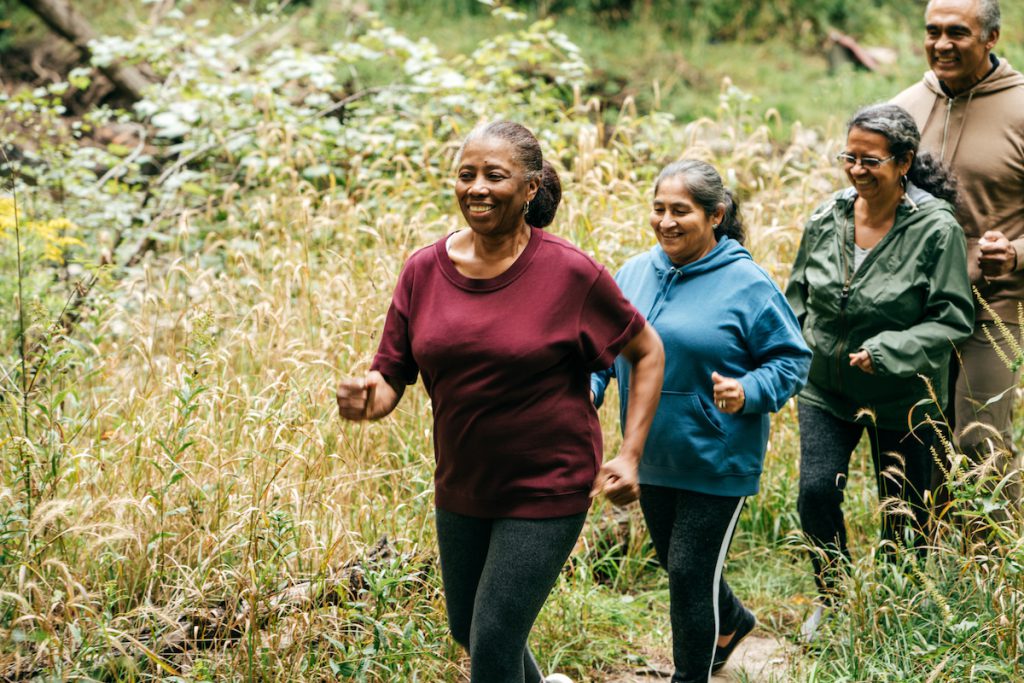Walking for Exercise: Your Secret Anti-Aging Power
Walking is key to staying independent and warding off disease as you age. Here’s what you need to know to walk your way to better health.

Walking is one of the easiest ways to maintain and improve your health from head to toe as you get older.
It might be surprising to hear that walking — a low-impact activity you’ve likely been doing for most of your life — can offer so many benefits. But studies have linked walking to better heart health, brain health, memory, and mental health. What’s more, walking can help boost mobility as you age.
The best part? You just need a pair of sneakers to get started. Here’s everything you need to know about walking so you can reap its many benefits.
Get and stay fit with SilverSneakers! Classes and events are happening right now at participating gyms, online through SilverSneakers LIVE, and at community centers near you. Activate your free online account to get started.
What type of exercise is walking?
Walking is a form of cardiovascular, or aerobic, exercise. By definition, cardio exercise is any activity that involves moving the large muscle groups continuously and in a rhythmic pattern. It increases your heart rate and makes you breathe harder than you might during routine daily tasks.
What are the physical health benefits of walking?
Aerobic exercises like walking keep your heart, lungs, and circulatory system in shape. This helps you carry out everyday tasks more easily, including walking around the grocery store, going up and down stairs, and playing with your grandkids.
It can also reduce your risk of heart complications. A European Journal of Epidemiology meta-analysis found that walking for 30 minutes a day, five days per week, was associated with a 19 percent lower risk of heart disease.
Walking may help with weight loss, too. It burns calories — about 133 in 30 minutes for a 155-pound person walking at a pace of 3.5 miles per hour. Burning more calories through physical activity can help you achieve the caloric deficit needed to lose weight. That said, it’s more effective to combine exercise with a reduced-calorie diet. According to the Physical Activity Guidelines for Americans, you’d have to walk at least 300 minutes per week to lose weight through exercise alone.
Walking is also linked to improved brain health. One study of older adults found that people who walked more than 4,000 steps daily had better brain function than those who walked fewer.
Keeping your brain healthy can help prevent dementia, or the loss of thinking, remembering, and reasoning that interferes with daily life. Researchers analyzed health and activity information for more than 78,000 healthy adults who were followed for seven years. They found that people who walked about 9,800 steps per day (about five miles) were 51 percent less likely to develop dementia than those who didn’t walk much.
You may see more benefits by walking with a friend. “If there’s a social component, it keeps your brain engaged while you’re exercising, which helps fight off dementia and other diseases that come with aging,” says Robert Linkul, CSCS, a personal trainer who specializes in working with older adults.
Recommended reading: The Incredible Power of a Post-Meal Walk
4 Health Secrets of Walking
What are the mental health benefits of walking?
Walking isn’t just good for your body. It can help boost your mental health, too. Research in JAMA Psychiatry linked regular walking to a lower risk for depression among adults.
Taking a walk in nature may have unique perks, especially where stress is concerned. One study found that an hour-long walk in a natural environment led to decreased activity in an area of the brain that responds to stress.
Do I need to walk at a certain pace or distance to see those health benefits?
Walking at any pace and distance is better than not walking at all. But you need to reach some minimums to see substantial health benefits.
Research suggests walking at a pace that makes you a little breathless and sweaty may lower your heart disease risk more than walking at a leisurely pace. And studies show that brisk walking may be just as effective as running for lowering your risk of high cholesterol, high blood pressure, and diabetes.
Aim for a pace that only allows you to speak in broken sentences, Linkul says. If you can still talk normally or sing, try to pick up the pace.
Walking at a brisk pace qualifies as a moderate-intensity aerobic exercise. The Physical Activity Guidelines for Americans recommend that older adults get at least 150 weekly minutes of this type of exercise for overall health. That equates to taking a 30-minute walk five days per week.
Achieving that minimum reduces your risk for chronic diseases, improves memory and thinking, and boosts your mood. And these benefits increase the more you move.
Good walking form is also important. Press play for a few tips:
What do I need to start a walking routine?
Starting a walking routine is pretty straightforward. The only gear you need is a pair of comfortable walking shoes and clothes you don’t mind getting sweaty.
Linkul recommends buying shoes designed specifically for forward motions like walking and jogging. Skip the sandals and tennis shoes.
A smartwatch is optional, but it can help you keep track of distance, pace, heart rate, step count, and more. This allows you to compare your past walking sessions and measure your progress. “You can go back and look at what you’ve done and see that you’re getting faster or going further,” Linkul says.
Once you have your gear, decide where you plan to walk. You can walk outside, on a treadmill, or around an indoor or outdoor track.
Linkul recommends walking over the ground whenever possible instead of using a treadmill. “When you’re responsible for propelling your body forward, there’s a lot more balance and coordination that goes into that, whereas when you’re on a treadmill, you basically have to keep up with the belt,” he explains.
Subscribe to our newsletter
It's quick and easy. You could be one of the 13 million people who are eligible.
Already a member? Click to discover our 15,000+ participating locations.
Follow Us
Choose a walking surface that enables you to walk safely. If the roads are icy or you live in a heavy-traffic area, you may need to walk indoors. Consider trying a SilverSneakers LIVE Walk Strong (Express) class. In just 15 minutes, your expert instructor will lead you through moves aimed to ease lower body stiffness, strengthen your stability muscles, and build confidence. View the schedule and RSVP here.
Recommended reading: Take the 7-Day Power Your Walk Challenge With SilverSneakers
5 Shoe Mistakes Many Older Adults Make
Are there any risks to walking?
The risk of injury with walking is low. However, you can get injured if you lose your balance or trip.
Stay safe by choosing routes that are smooth and stable. Try to walk on a sidewalk or path whenever possible and watch out for tripping hazards. If you have to walk on the side of the road, always face oncoming traffic.
It’s also a good idea to choose routes with places to sit (e.g., benches) in case you need a moment to rest.
People with diabetic neuropathy or nerve damage in their feet should always check their feet before going for a walk. Check for sores, infections, and ulcers and touch your toes to ensure you can feel the sensation.
As always, safety is key. Get your doctor’s OK before beginning a new exercise program. If you have a chronic condition (including osteoporosis), balance issues, or injuries, talk to your doctor about how you can exercise safely.
Recommended reading: 3 Reasons to Go for a Walk Today (That Have Nothing to Do With Your Heart)
Nordic Walking: Is This the Best Workout You’re Not Doing?
See our sources:
How older adults can exercise safely outdoors: National Institute on Aging.
Losing weight by walking: Mayo Clinic
Physical activity guidelines for Americans: U.S. Department of Health and Human Services
Aerobic exercise overview: American Heart Association
Study on link between walking and heart health: World Journal of Cardiology
Exercising safely with diabetes: American Diabetes Association
Study on how walking in nature can lower stress: Molecular Psychiatry.
Link between walking pace and disease risk: British Journal of Sports Medicine
Mental health benefits of walking: JAMA Psychiatry
How walking can boost your memory: Journal of Alzheimer’s Disease
Check Your SilverSneakers Eligibility Instantly
SilverSneakers members can go to thousands of gyms and fitness locations across the nation, plus take SilverSneakers LIVE online classes that are designed for seniors of all levels. If you have a Medicare plan, it may include SilverSneakers—at no additional cost. Check your eligibility instantly here.
Already a member? Get your SilverSneakers member ID and exclusive fitness content by activating your online account here.
Not eligible for SilverSneakers? You can still get 200+ free SilverSneakers On-Demand videos and stay in touch with us by creating your online account.





